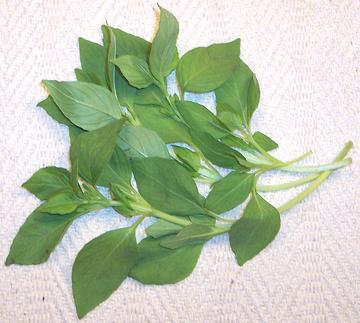 [Lao Basil, Lemon Basil (English); Buffalo Basil (Thai English);
Bai Maeng-lak (Thai); Pak i tou (Laos); Kemangi (Indonesia); Sangig
(Philippine); Partminger, Curry Leaf (Nigeria); Ocimum x africanum syn.
Ocimum x citriodorum]
[Lao Basil, Lemon Basil (English); Buffalo Basil (Thai English);
Bai Maeng-lak (Thai); Pak i tou (Laos); Kemangi (Indonesia); Sangig
(Philippine); Partminger, Curry Leaf (Nigeria); Ocimum x africanum syn.
Ocimum x citriodorum]
This is one of the basils that has become common in Southern California, often labeled "Thai Basil". It is characterized by a citrus fragrance, smaller light green pointed leaves and a relatively light flavor - and bad keeping properties (maybe 4 days if you take good care of it). It often alternates with Thai Purple Basil in produce markets. The stronger more aromatic flavor of the purple is better for most Thai cooking while the Lemon Basil is used mainly for salads and some soups. Lemon Basil is what Basil is in Laos and Indonesia, no others accepted.
In Nigeria there is great confusion, as this herb is called "Curry Leaf", and so is the real Curry Leaf (Murraya koenigii). They are cooked differently as M. koenigii does not cook tender enough to eat.
More on Basils.